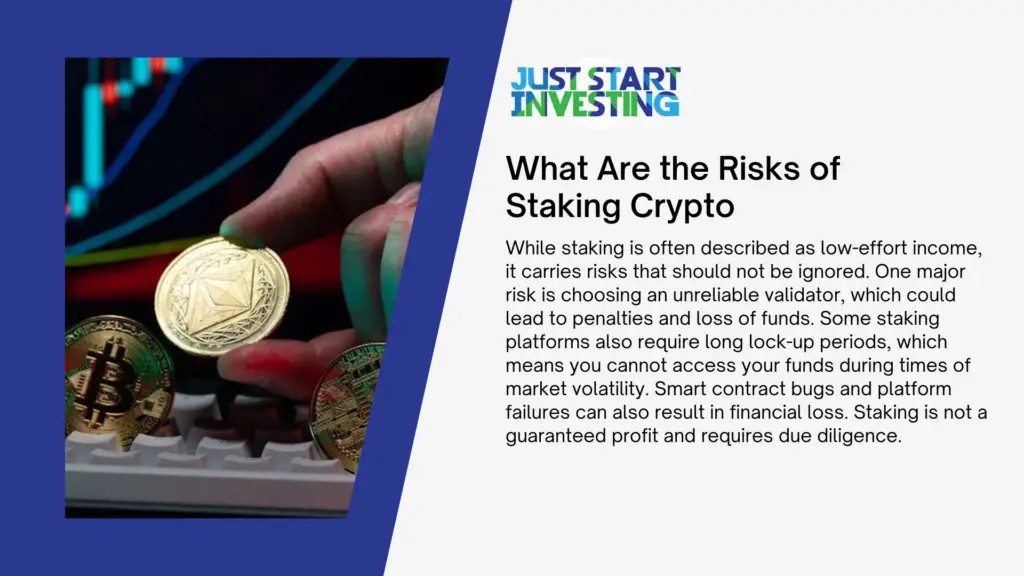Crypto staking lets you earn rewards while holding coins, but it also comes with risks you need to understand. It is a popular way to grow your crypto portfolio passively, especially with blockchains that rely on proof of stake mechanisms. In this guide, you will learn how staking works, its benefits and risks, and how to get started safely.
Getting Started with Crypto Staking

Crypto staking means locking your coins to help run a blockchain network. In return, you earn rewards. It is common in blockchains that use proof of stake. You help the system, and the system pays you back.
How Staking Secures a Blockchain Network
Staking is the process of locking up your cryptocurrency to support the operations and security of a blockchain network. In proof-of-stake blockchains like Ethereum, Cardano, and Polkadot, validators are chosen to confirm transactions based on how much crypto they have staked. This system encourages honesty because a validator who misbehaves can lose part of their stake.
Proof of Stake vs Proof of Work Explained
Proof of stake is an energy-efficient alternative to proof of work. Unlike Bitcoin’s proof of work system that relies on energy-intensive mining, proof of stake selects validators based on how much crypto they hold and commit to the network. This change reduces environmental impact and allows users to earn rewards for helping the network.
Coins You Can Stake and Where to Find Them
You can stake popular coins like Ethereum (ETH), Cardano (ADA), Solana (SOL), and Polkadot (DOT). These are available on major exchanges such as Binance, Coinbase, and Kraken, or through staking-specific platforms like Lido and Rocket Pool. Always make sure your chosen coin supports staking before you invest.
How Crypto Staking Generates Passive Income
Staking allows you to earn rewards simply by holding and delegating your cryptocurrency. The rewards come from transaction fees and new token issuance by the blockchain. As long as your staked tokens are active, you will receive a share of the rewards based on how much and how long you stake. This turns idle holdings into a steady stream of earnings over time. It is often viewed as one of the easiest ways to put your crypto assets to work.
Where Do Staking Rewards Come From
Staking rewards come from transaction fees and newly minted tokens issued by the network. When you stake your coins, you are helping confirm transactions and secure the blockchain. In return, you earn rewards, usually in the same token you are staking.
Annual Percentage Yield and Lock-Up Periods
The annual percentage yield for staking depends on the network and platform. Some coins offer 4 percent to 15 percent APY. Keep in mind that higher yields often involve more risk. Many staking options also require you to lock your coins for a set period during which you cannot withdraw them.
Choosing Between Wallets and Exchanges for Staking
You can stake directly from a non-custodial wallet like MetaMask or use centralized exchanges such as Binance or Coinbase. Wallet staking gives you more control over your funds, while exchanges are easier to use. Choose based on your comfort level and need for convenience or control.
What is Liquid Staking in Crypto
Liquid staking is an advanced version of traditional staking that gives you more flexibility with your assets. Instead of locking your tokens for a fixed period, you receive a tradeable token that represents your staked crypto. This allows you to earn rewards while still using or trading your assets in other parts of the crypto ecosystem. It appeals to users who want to maintain liquidity without sacrificing yield. Liquid staking has become more popular as decentralized finance tools evolve.
How Liquid Staking Works
Liquid staking allows you to earn rewards without locking your crypto. Instead of locking your tokens, you receive a tokenized version, such as stETH for Ethereum, which you can trade or use in decentralized finance while still earning staking rewards.
Key Differences Between Traditional and Liquid Staking
In traditional staking, your tokens are locked and cannot be used until the lock-up period ends. Liquid staking gives you a tradeable version of your staked tokens, giving you more flexibility. However, it usually depends on smart contracts that can carry technical risk.
Top Platforms Offering Liquid Staking
Top liquid staking platforms include Lido, Rocket Pool, and Ankr. These services let you stake coins like ETH and receive a liquid derivative in return, which you can use elsewhere in the crypto ecosystem.
What Are the Risks of Staking Crypto

While staking is often described as low-effort income, it carries risks that should not be ignored. One major risk is choosing an unreliable validator, which could lead to penalties and loss of funds. Some staking platforms also require long lock-up periods, which means you cannot access your funds during times of market volatility. Smart contract bugs and platform failures can also result in financial loss. Staking is not a guaranteed profit and requires due diligence.
Can You Lose Crypto Through Staking
Yes, staking involves risk. Although your staked coins remain in your account, you can lose part of them if the validator you choose performs poorly or breaks the rules. Research is essential before choosing a platform or validator.
Slashing and Penalties Explained
Slashing is a penalty applied when a validator acts dishonestly or goes offline too often. A portion of their stake, including any delegated funds from users, can be taken away permanently. This encourages validators to maintain high performance and reliability.
Smart Contract Vulnerabilities
Staking platforms that rely on smart contracts, such as liquid staking services, are vulnerable to bugs or attacks. Even well-reviewed platforms can experience technical failures. Make sure to use platforms with strong security practices and audits.
Platform Risks and Exit Restrictions
Centralized exchanges and third-party staking platforms may limit your ability to withdraw instantly. Some platforms enforce long unbonding periods or charge exit fees. Always check the withdrawal rules before staking your assets.
How to Start Staking Your Crypto
Starting with crypto staking is straightforward for most users, especially those using centralized exchanges or staking wallets. The process involves choosing a staking-compatible coin, selecting a trustworthy platform or validator, and locking in your tokens. Many platforms provide tutorials or guided steps for beginners, which reduces the learning curve. Once staked, you can start earning rewards and monitor your performance through the platform’s dashboard. With proper research, staking can become a reliable income stream.
Step-By-Step Guide for Beginners
- Choose a cryptocurrency that supports staking
- Decide whether to stake through a wallet or an exchange
- Select a reliable validator or staking pool
- Transfer your crypto and activate staking
- Monitor your earnings and adjust your strategy as needed
How to Choose a Reliable Staking Platform
Pick a platform with low fees, positive community feedback, and strong security. Look for services with open audits, clear terms, and active support. Kraken, Coinbase, and Lido are solid places to start for new users.
Tips to Reduce Risk and Maximize Returns
- Stake across multiple networks to spread your risk
- Reinvest rewards to benefit from compounding
- Keep track of validator performance and fees
- Avoid platforms that promise extremely high yields without transparency
Is Crypto Staking Right for You
Staking is well-suited for crypto holders who believe in the long-term success of a blockchain project. It allows you to grow your holdings over time without needing to trade frequently. However, it may not be ideal for users who need fast access to their funds or who frequently react to market changes. Before staking, it is important to evaluate your goals, your timeline, and your tolerance for risk. Not every crypto investor will find staking to be the right fit.
Who Benefits the Most from Staking
Staking is best for long-term crypto holders who are not actively trading. It allows them to earn regular rewards while supporting the network. If you plan to hold your assets anyway, staking helps you get more from them.
Short-Term vs Long-Term Staking Goals
Staking works best when you are focused on long-term growth. If you need to access your funds quickly or expect short-term price swings, staking may not be the right option. It is a better fit for patient investors.
How to Build a Diversified Staking Strategy
Use a mix of coins, validators, and staking methods. Combine traditional and liquid staking depending on your goals. Keep risk lower by using trusted platforms and regularly reviewing your staking performance.
Final Thoughts
Crypto staking is a simple way to earn extra rewards with your coins. It is a good option for people who want to hold their crypto and earn at the same time. Still, you need to be careful when choosing where and how to stake. There are some risks, like losing access to your coins or picking a bad platform. If you take the time to learn, staking can be a smart and easy way to grow your crypto.
Balancing Rewards and Risks in Staking
Staking is a powerful way to earn passive income, but it is not risk-free. You should understand validator reliability, smart contract safety, and platform policies before committing funds. Informed decisions lead to better outcomes.
How Staking Fits into a Broader Crypto Investment Plan
Staking complements other strategies like buying and holding or yield farming. It allows you to grow your holdings without selling them. This can help you build wealth while remaining active in your favorite blockchain ecosystems.
The Future of Staking in Evolving Blockchain Ecosystems
The staking world is expanding with better tools, safer platforms, and more flexible options like liquid staking. As technology improves and adoption grows, staking may become a standard part of crypto investing for millions of users.

Just Start Investing is a personal finance website that makes investing easy. Learn the simple strategies to start investing today, as well as ways to optimize your credit cards, banking, and budget. Just Start Investing has been featured on Business Insider, Forbes, and US News & World Report, among other major publications for its easy-to-follow writing.
